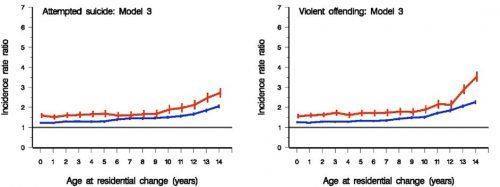More than once, I’ve considered packing up the family and taking a job in a different city. Each time, my wife and I thought about what it might do to them if we moved. But we were just guessing. There are data!
From The American Journal of Preventive Medicine, “Adverse Outcomes to Early Middle Age Linked with Childhood Residential Mobility“:
Introduction: Links between childhood residential mobility and multiple adverse outcomes through to maturity, and effect modification of these associations by familial SES, are incompletely understood.
Methods: A national cohort of people born in Denmark in 1971–1997 were followed from their 15th birthdays until their early forties (N=1,475,030). Residential moves during each age year between birth and age 14 years were examined, with follow-up to 2013. Incidence rate ratios for attempted suicide, violent criminality, psychiatric illness, substance misuse, and natural and unnatural deaths were estimated. The analyses were conducted during 2014–2015.
I have trouble sometimes in my own institution getting data on all the people with certain conditions cared for in the clinics we run. So when I see data like these, containing information on every single person born in Denmark from 1971-1997, I get a tear in my eye. But their amazingness is our gain.
Researchers took this cohort of almost 1.5 million Danes (sigh) followed from their 15th birthdays until their early 40s, which also contained data on their residential moves each year from birth until 14 years of age (sigh). They also could look at the incidence of mental health issues, substance abuse, attempted suicides, and criminality. They also could look at unnatural deaths.
While no cohort study is perfect, this one controlled for urbanicity at birth, parental age at birth, family history of mental disorders, parental socioeconomic status, age at follow-up, calendar year, and gender.
Only moves that crossed a “municipal boundary” were counted, as these would require a change in school. More than a third of kids had at least one such move before they turned 15 years old. It seems that parents were more likely to move a child when they were younger, too. More than 7% of kids were moved in their first year of life, compared to less than 3% of kids in their 14th year.
Now for the results. Kids who moved had a higher rate of all of the outcomes of interest (which were bad). Kids who were moved more often saw worse outcomes. Kids who were older when they were moved saw worse outcomes than kids who were younger, and moves in mid-adolescence were associated with sharp spikes in rates of bad outcomes.
With respect to attempted suicide and violent criminality, these spikes were seen across the socio-economic spectrum. It wasn’t just a problem with poorer individuals. This is the fully adjusted model:
The blue line is for kids who had one residential move in a year of their childhood. The red line is kids who had more than one such move.
Now for the caveats, and there are many worth considering. This is a study of Denmark, which isn’t necessarily representative of the rest of the world. In fact, there are few places that keep records like these on all their citizens, and that alone sets it apart in many ways.
It’s also possible that moving could be a proxy for other problems in a family. Moving could be a marker of family chaos or dusfunction. It could also be a marker of divorce or family disruption. Theoretically, this could even be reverse causality. Maybe families move more when something is wrong with their child.
But let’s not ignore the fact that moves are hard on kids. They disrupt their friendships and social ties. It’s not unrealistic to think that this could cause some percentage of them to have issues or problems.
The bottom line is that this is a data point in support of the fact that moving is disruptive to children’s lives and health. Some moves are unaviodable. That doesn’t mean we shouldn’t pay attention to the fact that kids may need extra help, attention, and maybe even resources when they occur.


